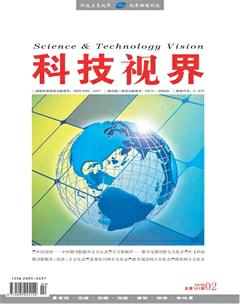Study of signal—to—noise ratio driven by colored noise
ZHAO+Jin
【Abstract】This paper investigates the signal-to-noise ratio(SNR) driven by colored noise and weak input signals. Based on the Cauchy-Schwarz and Rayleigh quotients inequalities, an analytical expression of SNR is developed, and its upper band is closely related to the Fisher information of noise. For mimicking the colored noise, we adopt the first-order moving-average model and propose the optimal input signal waveform. The stochastic resonance effect in threshold systems is demonstrated for the Gaussian mixture colored noise. The obtained results will be interesting in the case of improving the nonlinear filter performance by adding noise to the weak signal corrupted by the colored noise.
【Key words】Colored noise; Signal-to-noise ratio; Moving-average model.
0 Introduction
As a kind of important statistics,Stochastic resonance phenomenon first was suggested by Benzi[2] when he study the glacier problems of world.Then, Fauve and Heslot also Confirm this theory In the field of signal processing when they study the Schmitt trigger circuit[3].For modulation signal,Through constantly turn the noise intensity,Confirmed the output signal-to-noise ratio of Schmitt trigger has a peak under nonzero intensity noise.Thereupon,Stochastic resonance caused the extensive research interest of scholars In the field of nonlinear signal processing.Such as the study of neurons, the study of the complex signal processing. Nearly 30 years, the stochastic resonance has gradually grown into a kind of new method for weak signal enhancement processing. On the basis of the development of some nonlinear theory, such as Aperiodic stochastic resonance[4] and super threshold stochastic resonance[5], for neuroscience[6], information theory, and biomedical engineering also has important application value.In stochastic resonance measures indicators,the signal-to-noise ratio and signal-to-noise ratio gain occupies an important position.Fauve and Heslot quantitatively?describe the phenomenon of stochastic resonance?for the first time by introduced the Signal-to-noise ratio[3].Signal-to-noise ratio is defined as the ratio of system output power spectrum of signal power with the same frequency background noise power[1-3].For using the method of stochastic resonance to increase the output SNR of signal,the technology of Stochastic resonance is artificially adding white noise in the system[1-7].However,there is no ideal white noise in many practical cases[8-11].Although many studies found that increasing of colored noise correlation time is unfavorable factors to the performance of the system[8],But under certain conditions,Colored noise is better than white noise that can enhance nonlinear system response to weak signal[9-11]. As a result, the correlation of colored noise same as noise intensity, both can translate into the favorable factors of Improving the output SNR. Making the system performance better than in the case of white noise. This article is based on the results of the study,Under the hypothesis of weak signals,This paper presents output signal-to-noise ratio which driven by colored noise, and presents the relations between theoretical upper limit of Signal-to-noise ratio and Fisher information. For mimicking the colored noise, we adopt the first-order moving-average model and propose the optimal input signal waveform. The stochastic resonance effect in threshold systems is demonstrated for the Gaussian mixture colored noise.
1 Signal-to-noise ratio(SNR) gain of a nonlinear filter
1.1 The nonlinear filter
Ewn[·]=∫·fwn(w0)dw0. From(16) we can get,Given the correlation coefficient ?籽1,2, Normalized maximum output signal-to-noise ratio is monotone decreasing function of noise intensity ?滓w, That means no phenomenon of stochastic resonance. But given the intensity of a noise, NSNRmax is monotone increasing function of correlation coefficient ?籽1,2, Colored noise can improve the output signal-to-noise ratio, But at the cost of the input signal must be selected as the corresponding eigenvectors.
3 Conclusion
In this paper we optimize the coefficient vector and the transformation function in nonlinear filter, get the expression and upper limit of output signal-to-noise ratio under the weak signal.In development, When a given input signal power, we can optimize and solve signal waveform that can get the calculation method of maximum output signal-to-noise ratio of first-order moving-average model. We analyze the color noise generated by scale and gaussian mixture noise,confirme the stochastic resonance phenomenon of signal-to-noise ratio of gaussian mixture noise in the threshold system.
【The Reference】
[1]Benzi R, Sutera A, Vulpiani A. The mechanism of stochastic resonance[J]. Journal of Physics A: Mathematical and General, 1981,14(11):L453-457.
[2]Benzi R, Parisi G, Sutera A, Vulpiani A. Stochastic resonance in cfimatic change[J]. Tellus, 1982, 34(1):10-16.
[3]Fauve S, Heslot F. Stochastic resonance in a bistable system[J].Physics Letters A, 1983, 97(12):5-7.
[4]Collins JJ, Chow CC, Imhoff TT. Aperiodic stochastic resonance in excitable systems[J]. Physical Review E, 1995(52): R3321 R3324.
[5]Stocks NG. Suprathreshold stochastic resonance in multilevel threshold systems[J]. Physical Review Letters, 2000(84): 2310 2313.
[6]Collins JJ, Priplata AA, Gravelle DD, Niemi J, Harry J. Noise-enhanced human sensor-motor function[J]. IEEE Engineering in Medicine and Biology, 2003(22):76 83.
[7]Priplata AA, Patritti BL, Niemi JB, Hughes R. Noise-enhanced balance control in patients with diabetes and patients with stroke[J]. Annals of Neurology, 2006(59): 4 12.
[8]H?覿nggi P, Jung P, Zerbe C, Moss F Can colored noise improve stochastic resonance?[J]. Journal of Statistical Physics, 1993(70): 25 47.
[9]Duan F, Chapeau-Blondeau F, Abbott D. Stochastic resonance with colored noise for neural signal detection[J]. PLoS ONE 9(3):e91345.
[10]Poor HV. Signal detection in the presence of weakly dependent noise-part I: Optimum detection[J]. IEEE Transactions on Information Theory, 1982(28): 735 744.
[11]Poor HV. Signal detection in the presence of weakly dependent noise-part II: Robust detection[J]. IEEE Transactions on Information Theory, 1982(28):744 752.
[12]Manolakis DG, Ingle VK, Kogon SM. Statistical and adaptive signal processing[M]. The McGraw-Hill Education Publishing, New York, 2000.
[责任编辑:王楠]

